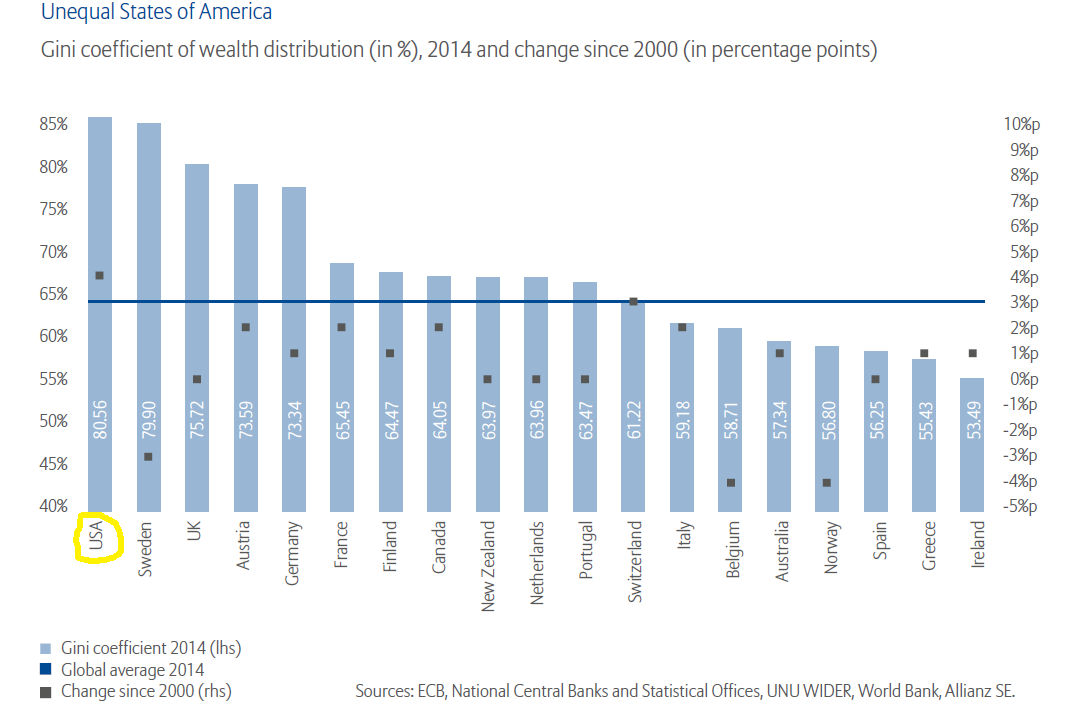Inequality in the United States of America(USA), as measured by the Gini Coefficient, is the highest among developed countries. Inequality has always been high in the US. However in the years since 2000, it has increased sharply to much higher levels. Since the US follows the capitalist system of government, inequality will always be high when compared to other developed countries which follow socialism. However what is concerning is that the sharp increase in the rate of inequality in recent years.
The Gini Coefficient is measure of inequality of income or wealth of a country’s residents. In simple terms, the higher the measure the worse the inequality is. From Wikipedia:
The Gini coefficient (also known as the Gini index or Gini ratio) (/dʒini/ jee-nee) is a measure of statistical dispersion intended to represent the income distribution of a nation’s residents, and is the most commonly used measure of inequality. It was developed by the Italian statistician and sociologist Corrado Gini and published in his 1912 paper “Variability and Mutability” (Italian: Variabilità e mutabilità).[1][2]
The Gini coefficient measures the inequality among values of a frequency distribution (for example, levels of income). A Gini coefficient of zero expresses perfect equality, where all values are the same (for example, where everyone has the same income). A Gini coefficient of one (or 100%) expresses maximal inequality among values (for example, where only one person has all the income or consumption, and all others have none).[3][4] However, a value greater than one may occur if some persons represent negative contribution to the total (for example, having negative income or wealth). For larger groups, values close to or above 1 are very unlikely in practice.
Source: Gini coefficient, Wikipedia
The following chart shows the Gini coefficient of wealth distribution (in %), 2014 and change since 2000 (in percentage points) among select developed countries:
Click to enlarge
Only Sweden, Belgium and Norway do not fit the pattern in the above chart. In all the other countries, the Gini remains high and the change since 200 also increased. Inequality in Sweden is the highest among rich countries next only to the US. However since 2000, the rate has not increased greatly. Comparing the US to other developed countries, the authors of the report note the following:
Unequal States of America
The same cannot be said for the US, where the crisis and the sluggish economic recovery that followed have caused a dramatic deterioration in wealth distribution. The increase in inequality, i.e. the rise in the Gini coefficient, is more pronounced here than in any other country during the period analyzed. The result: the USA (which, the way things are going, could well be taken to stand for the ”Unequal States of America”) has the highest Gini coefficient in our analysis. It is, unfortunately, impossible to tell at this stage whether this is largely the result of asset accumulation setbacks brought on by the crisis, which hit smaller and medium-sized assets particularly hard, or whether the developments are already the result of the digital revolution which, at least for the main protagonists, is increasingly turning out to be a ”wealth catalyst”.
Source: Allianz Global Wealth Report 2015, Allianz




